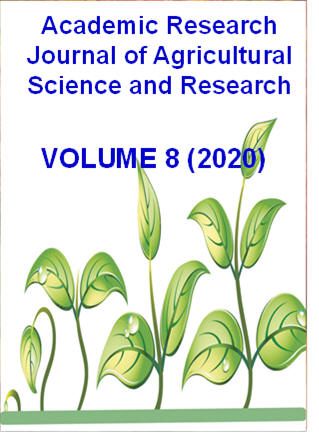|
ISSN: 2360-7874 |
Academic Research Journal of
Agricultural Science and Research |
|||||||||||||||||||
|
Vol. 8(5), pp. 492-504, June 2020 Review Estimate of genetic variability components via quantitative traits in coffee (coffeaarabica L.) germplasm in Ethiopia Masreshaw Yirga1, Wosene Gebreselassie2 and Abush Tesfaye3
1Jimma Agricultural Research Center, P. O. Box,, 192, Jimma, Ethiopia 2College of Agriculture and Veterinary Medicine, Jimma University, P.O. Box, 307, Jimma, Ethiopia 3 International Institute of Tropical Agriculture, Nigeria
Accepted 14 June 2020
Detail identification and quantification of genetic variability in the base population is an important for a successful conservation and utilization of genetic resources in coffee improvement work. The study was undertaken at Metu Agricultural Research Sub Center to estimate the extent of genetic variability of coffee. Sixty two Coffee germplasms along with two check varieties (74110 and 74112) were used for this study. The experiment was superimposed during 2018 cropping seasons on six years old coffee trees which was laid down in 8x8 simple lattice design. The accessions were established under uniform temporary shade trees of Sesbaniasesban and other managed practices were applied as per the coffee agronomic production practice to the orchard.Data on 25 quantitative traits were recorded from four representative trees per row. Analysis of variance revealed the presence of significant (P<0.05) difference among the tested accessions for most of the traits. The maximum tree yield (0.58kg) was recorded on the accession Y105, while the minimum (0.20kg) was obtained from Y73. The high yielding accession (Y105) exhibited a yield advantage of 107.14% and 61.11% relative to check varieties (74110 and 74112), respectively. High phenotypic (PCV) and moderate genotypic coefficients of variations (GCV) were recorded for yield per tree and number of secondary branches; while high PCV and GCV values were recorded for coffee berry disease and coffee leaf rust reactions. However, the differences between PCV and GCV for these genetic advance as percent of mean was obtained for secondary branches, suggesting that this trait was under the control of additive gene action. Therefore, this trait can be improved through selection easier than other traits. Generally, the present study revealed the existence of immense genetic variability among coffee germplasm for important morphological traits. Hence, there is an opportunity traits were higher except for number of secondary branches. High heritability coupled with high expected to exploit these traits to develop genotypes that perform better than the existing varieties for the future coffee improvement program.
Key words:CoffeaarabicaL., GCV, PCV, Heritability, GA
How to cite this article (APA Style): Masreshaw Y., Wosene G., Abush T(2020). Estimate of genetic variability components via quantitative traits in coffee (coffeaarabica L.)germplasm in Ethiopia. Acad. Res. J. Agri. Sci. Res. 8(5): 492-504
|
|||||||||||||||||||
